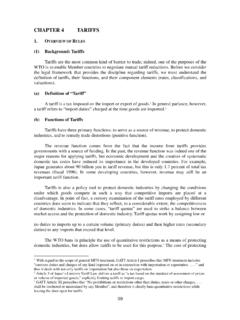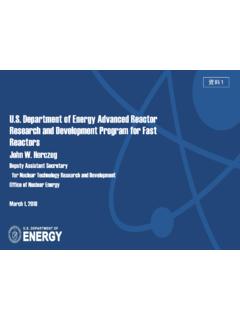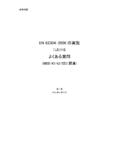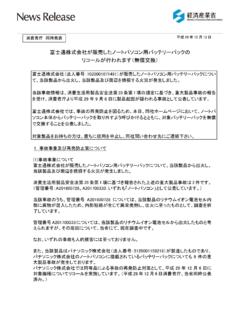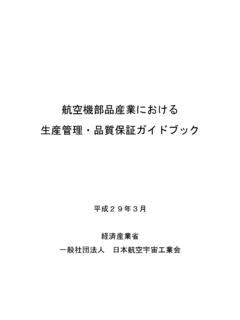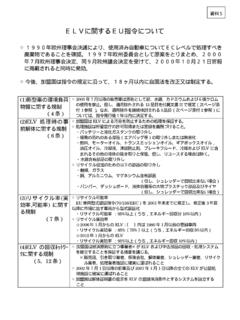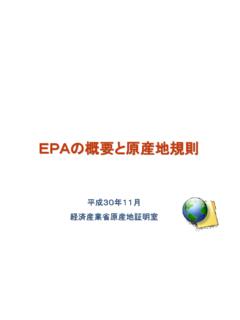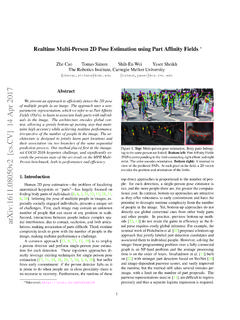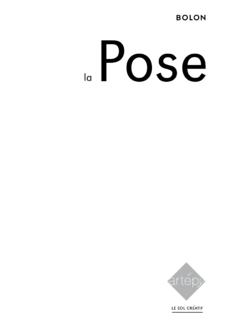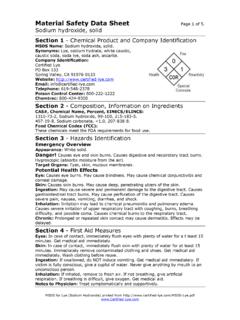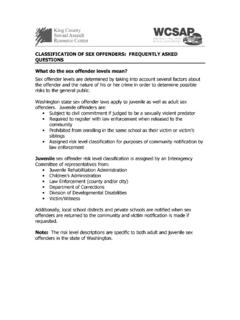Transcription of *This is a provisional translation. Pursuant to the ...
1 1 *This is a provisional translation. December 28, 2009: , Ministry of Health, Labour and Welfare Ministry of Economy, Trade and Industry Ministry of the Environment Pursuant to the provision of Article 3, paragraph (1), item (vi) of the Act on the Evaluation of Chemical Substances and Regulation of Their Manufacture, etc. (Law No. 117 of 1973), the evaluation criteria related to new chemical substances that are polymers and that do not pose a risk of causing damage to human health or the habitat and/or growth of flora and fauna in the human living environment by causing environmental pollution, is specified as follows and become effective as of April 1, 2010. December 28, 2009 Akira Nagatsuma, Minister of Health, Labour and Welfare Masayuki Naoshima, Minister of Economy, Trade and Industry Sakihito Ozawa, Minister of the Environment Evaluation criteria of new chemical substances that are polymers and that do not pose a risk of causing damage to human health or the habitat and/or growth of flora and fauna in the human living environment by causing environmental pollution 1.
2 Polymers shall be those that fall under items (1) and (2) below: (1) Any chemical substance composed of an aggregation of those molecules that are produced by the sequence of one or more types of monomeric units, in which the total weight of those molecules that are composed of 3 or more monomers makes up 50% or more of the weight of the whole substance and the total weight of those molecules with same molecular weight is less than 50% of the weight of the whole substance; and (2) Any chemical substance whose number average molecular weight is 1,000 or more. 2. New chemical substances that are polymers and that do not pose a risk of causing damage to human health or the habitat and/or growth of flora and fauna in the human living environment by causing environmental pollution, shall be those chemical substances that fall under item (1) or (2) below: (1) Polymers that satisfy all of the following requirements: (i) The following stability criteria should be satisfied in physicochemical stability testing: a.
3 There is no change in excess of 2% in the weight of the test substance before and after testing in any test solution pH; 2 b. There is no change in excess of 5 ppm in the content of dissolved organic carbon (hereinafter referred to as DOC ) before and after testing in any test solution pH; c. There is no change in the IR spectrum before and after testing in any test solution pH; and d. There is no change in the molecular weight of the test substance before and after testing in any test solution pH; (ii) There is no change in excess of 2% in the weight of the test substance before and after testing, or no cationic property is indicated in the main chin of the test substance, in tests of solubility with respect to acid and alkali; (iii) There is no change in excess of 2% in the weight of the test substance before and after testing regarding any test solvent, in tests of solubility with respect to water and organic solvents; and (iv) No metal except for sodium, magnesium, potassium or calcium is contained in the chemical structure.
4 Or (2) Polymers that satisfy all of the requirements described in items (1)(i), (ii) and (iv) above as well as items (i) through (iii) below: (i) Polymers that do not fall under item 1(iii) above, regarding which the content of components with molecular weights of less than 1,000 is below 1% and there is no finding suggesting a highly bioaccumulative property; (ii) No arsenic or selenium is contained in the chemical structure; and (iii) Polymers that fall under item a or b below: a. The number average molecular weight is 10,000 or more; or b. Regarding those that do not fall under item a above, the monomers composing the polymers are existing chemical substances, etc., and no carbon-carbon double bond, carbon-carbon triple bond, carbon-nitrogen double bond, carbon-nitrogen triple bond, aziridyl group, amino group, epoxy group, sulfonate group, hydrazino group, phenolic hydroxyl group or fluoro group is contained in the chemical structure.
5 3. The compliance of chemical substances with the requirements of the criteria shall be evaluated by the test method described below. (1) Technical terms The technical terms to be used in the test methods shall be in accordance with the Japanese Industrial Standards (JIS K 0211 (Technical terms for analytical chemistry (General part)), JIS K 0215 (Technical terms for analytical chemistry (Analytical Instrument part)), JIS K 7252 (Plastics Determination of average molecular mass and molecular mass distribution of polymers using size-exclusion chromatography), JIS Z 8801 (Test sieves), etc.). (2) Preperation of test substances Test substances shall be those with the smallest average molecular weight. However, in cases where 3 chemical substances are dissolved or dispersed in a solvent at the time of synthesis, any polymer should be isolated from the solvent without causing any change in the properties of the chemical substances and used as test substances.
6 (3) Test methods (i) Test method for the physicochemical stability and the solubility with respect to acid and alkali a. Particle size of the test substance: Particle size of 60 to 80 mesh should be used for the measurement. b. Test medium pH: The pH values of , , and , which are adopted in the OECD Guidelines for the Testing of Chemicals (Decisions by the OECD Council [C (81) 30 Final Attached Sheet 1]) 111 Hydrolysis as a Function of pH shall be used. In addition, whenever there is any branched chain that can be subject to hydrolysis, direct analysis, etc., should be carried out to confirm the physicochemical stability. c. Test temperature: 40 2 C d. Light: Indoor light e. Air: Contact with air should be made by stirring the test liquid.
7 F. Test period: 2 weeks; except for the case of pH where the period should be 24 hours. g. Test concentration of the test substance: 1,000 mg/L; however, when testing is difficult due to the nature of the test substance, the test concentration can be changed within the range of 100 mg/L to 10,000 mg/L. h. Number of cycles (repetition): 2 cycles i. Analysis: The weight, DOC, IR spectrum and molecular weight distribution should be analyzed at the start and end of tests in order to examine whether there is any chemical change. However, this can be excluded if there is an unavoidable reason. (ii) Test method for solubility with respect to water and organic solvents a. Test solvent (a) Water (b) n-octanol and n-heptane (indicators for affinity to fat) (c) Tetrahydrofuran (hereinafter referred to as THF ) and dimethylformamide (hereinafter referred to as DMF ) Note: Instead of DMF, dimethyl sulfoxide (hereinafter referred to as DMSO ) or 1-methyl-2-pyrrolidone (hereinafter referred to as NMP ) can be used.
8 B. Test temperature: 35 C to 40 C should be used. c. Test time: to be stirred for 1 hour d. Equilibrium: Equilibrium should be maintained for 24 hours at 25 2 C. e. Test concentration of the test substance: 2,000 mg/L f. Particle size: 60 to 80 mesh should be used for the measurement. 4 g. Number of cycles (repetition): 2 cycles h. Stirring: For contact with the solvent, slow stirring or shaking should be steadily carried out. i. Analysis: After the test liquid has been filtered, weight changes should be examined by making the mass of the residual sample constant. In cases where the filtering method cannot be used due to any property of the test substance, such as expansion or adhesion to the container, etc., the residual sample and the test liquid can be separated by another method.
9 When it is difficult to carry out a gravimetric analysis of the residual sample, the dissolved portion can be subjected to a gravimetric analysis if the separated test liquid is exsiccated. Analysis of DOC should also be carried out in regard to water. j. Determination of solubility: Essentially, the insolubility of the substance with respect to water and four types of organic solvents should be confirmed. Furthermore, when it is determined that the substance has dissolved in one of the solvents including water and four types of organic solvents, at least the solubility data with respect to water should be prepared. (iii) Method of measuring the molecular weight distribution When dissolution of the substance has been determined in item (ii)j, steric exclusion chromatography (hereinafter referred to as SEC ) should be carried out while paying attention to the following points: a.
10 Eluants Any of the general-purpose eluants listed below should be used. In cases where the test substance does not dissolve in any general-purpose eluant, use of those specific eluants described in item (b) below should also be considered. In cases where the substance does not dissolve at a temperature prescribed in the Japanese Industrial Standards (JIS K 7252), heat dissolution testing can be carried out by using o-dichlorobenzene (hereinafter referred to as ODCB ), toluene, DMF or water. (a) General-purpose eluants: THF, chloroform, dichloromethane, toluene, DMF, water (including buffers), etc. (b) Specific eluants: 1,1,1,3,3,3-hexafluoro-2-propanol (HFIP), 1,2,4-trichlorobenzene (TCB), ODCB, toluene, 1,2-dichloroethane, NMP, m-cresol, benzene, DMSO, tetrachloroethylene, 2-chlorophenol, trifluoroethanol, etc.
